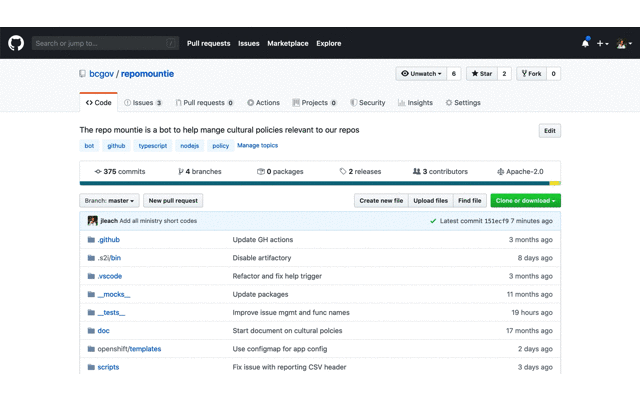This repo is a GItHub Action that enables a GitHub repository to trigger a deployment to OpenShift. This is intended to be used to spin up a new environment when a new pull request is created or when code is pushed to or merged into a branch.
This action was built specifically with GitHub Flow and Continuous Deployment in mind.
Applications using the pipeline must be Dockerized. This action expects to find a Dockerfile in the root directory of consumer projects. The Docker image must expose a port via EXPOSE {{MY_PORT_NUMBER}} e.g. EXPOSE 3000.
Note that this pipeline is currently targeted at simple REST API applications and web client applications. Please review the server and client build config templates and deployment config templates and ensure they are appropriate for your application.
Dockerized applications that wish to use this action must create a GitHub actions workflow of their own. See GitHub's documentation. As an example, save the following to your repository as /.github/workflows/action.yml.
name: Pull Request Deployment
on: pull_request
jobs:
deploy:
name: OpenShift Deployment
runs-on: ubuntu-latest
steps:
- name: Checkout
uses: actions/checkout@v2
- name: Use Pipeline Action
uses: bcgov/[email protected]
with:
MODE: server
AUTH_TOKEN: ${{ secrets.AUTH_TOKEN }}
NAMESPACE: myproject-dev
APP_NAME: myapp-pr${{ github.event.number }}Note that more jobs may be added and the above demonstrates only the OpenShift deployment job. Additionaly jobs may be running tests, static analysis, etc.
Imputs to this action are supplied via the with property in a consumers action.yml file. Some inputs are required regardless of the MODE supplied while other are required specifically for the client or server config templates.
Please note that the port exposed by the consuming repo's Dockerfile must match the port supplied as the SERVER_PORT or CLIENT_PORT input, depending on the MODE used.
| Name | Required | Description |
|---|---|---|
| MODE | All | Either "server" or "client" depending on the desired config template |
| AUTH_TOKEN | All | Authorization token used to login to OpenShift cluster, see Authorization section of this document |
| NAMESPACE | All | Namespace in which to build and deploy the application |
| APP_NAME | All | Name of the application e.g. my-app-name-pr4 |
| BRANCH | None | Branch of the application repo that is to be deployed, defaults to master |
| SERVER_PORT | None | Port exposed by the server, must match port exposed by Dockerfile, defaults to 5000 |
| CLIENT_PORT | None | Port exposed by the client, must match port exposed by Dockerfile, defaults to 3000 |
| API_URL | Client | The URL that is exposed by the route in the server application, available as env var in client |
Currently, setting arbitrary environment variables is not supported. These will need to be set in your Dockerfile using ENV [NAME] [VALUE]. See relevant Docker documentation.
This GitHub Action uses the OpenShift CLI to deploy an application. All commands used can be seen in the Makefile. At a high level, the action runs either the create-server or create-client make commands, depending on the MODE input supplied.
In detail, this repository presents itself as a GitHub Action via metadata in the action.yml file. This action creates a Docker container that includes the OpenShift CLI. It immediately runs entrypoint.sh which logs into your OpenShift cluster using the provided token.
Next, any previous builds of the same name are cleared from the cluster. The Makefile processes config templates stored in the openshift directory, filling in any parameters. The server.(bc|dc).json or client.(bc|dc).json template is chosen for MODE "server" and "client", respectively. The processed template is then pushed to OpenShift using oc apply.
Currently, the action does not define or run unit tests. Until a spec is developed that allows generalization of running tests, they must be added by the consumer repository in the action.yml file.
This action accesses your OpenShift cluster on your behalf. To enable this access, it is recommended that a service account is created. The following outlines how an OpenShift authorization token can be aquired.
- Login to the OpenShift console
- From the navbar dropedown menu, select Cluster Console
- Select Administration > Service Accounts > Create Service Account
- Edit the YAML to allow access to the desired namespace
- Within the newly created service account, select the secret that contains "token" in the name
- Click Copy to Clipboard on the "TOKEN" data value
The service account created will also need to have a role bound to it.
- From the OpenShift Cluster Console, select Administration > Role Bindings > Create Binding
- Give the role binding a name such as "GitHub Admin"
- Select the namespace that the service account was created in
- Select "admin" as the Role Name
- Select "Service Account" as the Subject
- Select the namespace of the service account and add its name as the Subject Name
- Click Create Binding
This token can be saved as a GitHub secret in your repo. Navigate to Settings > Secrets and name the secret appropriately. Note that an OpenShift service account can have access to only one namespace. Depending on your workflow and CI/CD pipeline, you may need several service accounts and therefore secrets.


